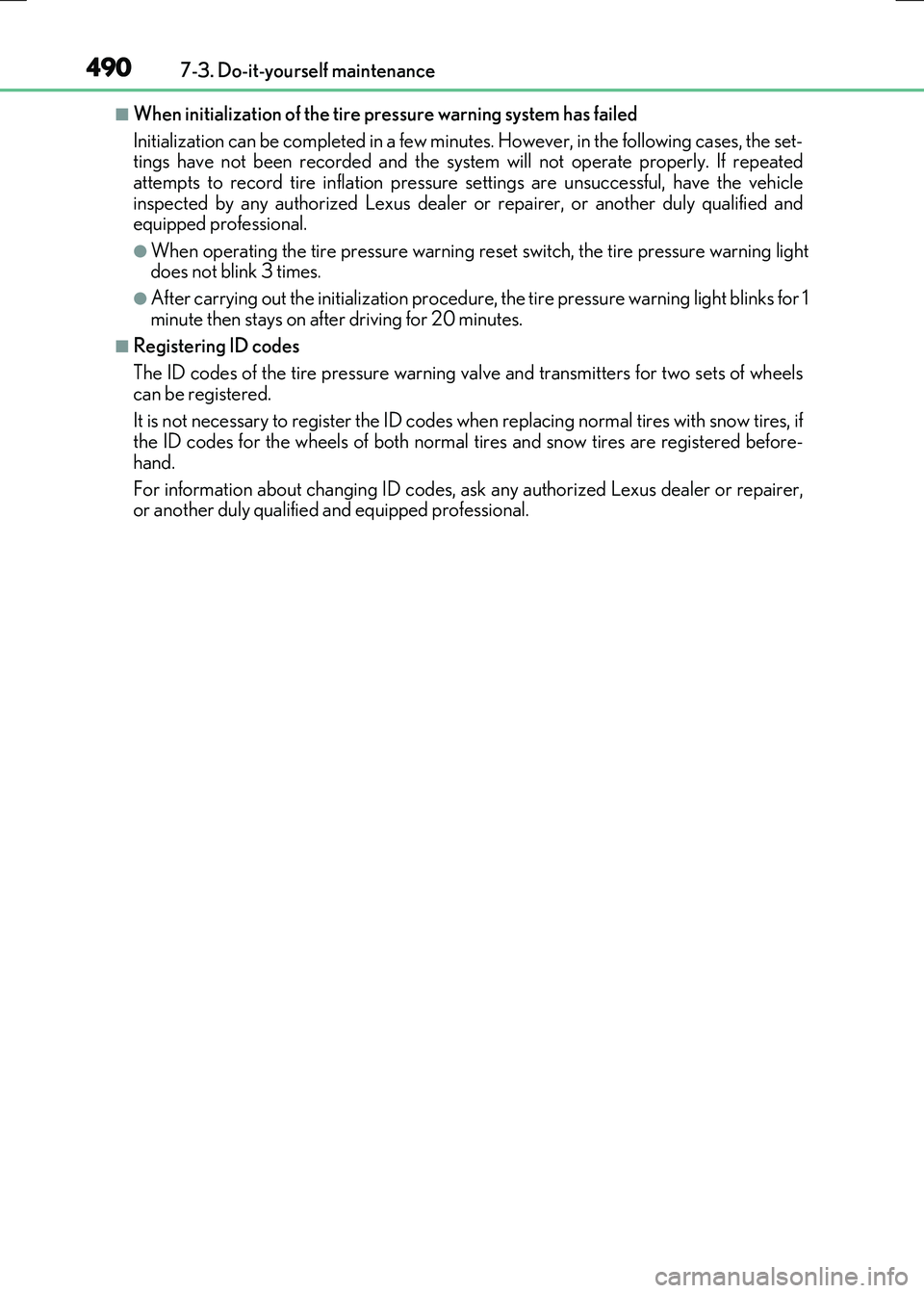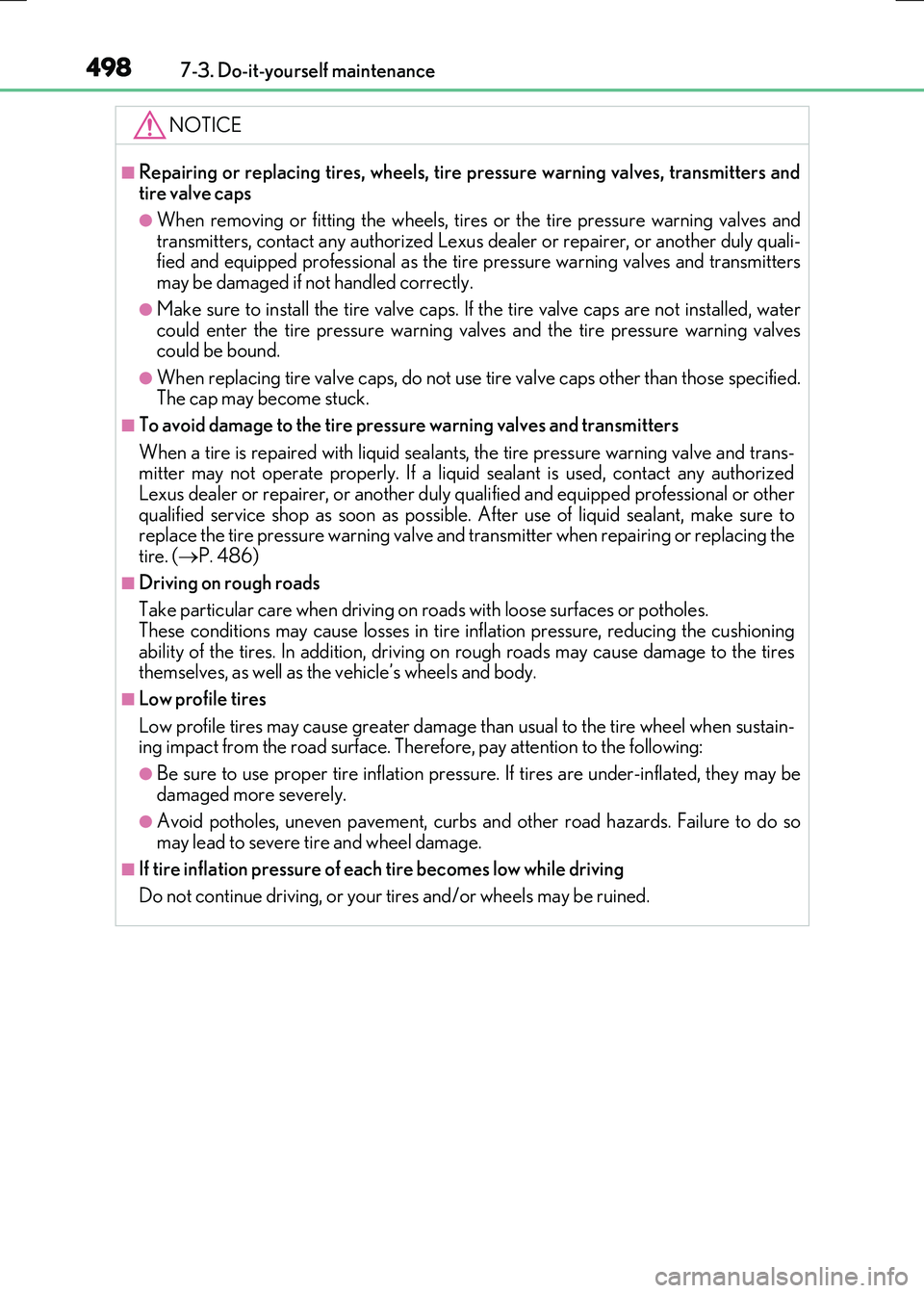Page 489 of 640

4897-3. Do-it-yourself maintenance
7
Maintenance and care
RC300h_EE(OM24740E)
■Situations in which the tire pressure warning system may not operate properly
●In the following cases, the tire pressure warning system may not operate properly.
• If non-genuine Lexus wheels are used.
• A tire has been replaced with a tire that is not an OE (Original Equipment) tire. • A tire has been replaced with a tire that is not of the specified size.• Tire chains etc. are equipped.
• An auxiliary-supported run-flat tire is equipped. • If a window tint that affects the radio wave signals is installed.• If there is a lot of snow or ice on the vehi cle, particularly around the wheels or wheel
housings. • If the tire inflation pressure is extr emely higher than the specified level. • If tires not equipped with tire pressure warning valves and transmitters are used.
• If the ID code on the tire pressure warning valves and transmitters is not registered in the tire pressure warning computer.
●Performance may be affected in the following situations.
• Near a TV tower, electric power plant, gas station, radio station, large display, air- port or other facility that generates st rong radio waves or electrical noise
• When carrying a portable radio, cellular phone, cordless phone or other wireless communication deviceIf tire position information is not correctly displayed due to the radio wave conditions,
the display may be corrected by driving and changing the radio wave conditions.
●When the vehicle is parked, the time taken for the warning to start or go off could be extended.
●When tire inflation pressure declines rapi dly for example when a tire has burst, the warning may not function.
■The initialization operation
●Make sure to carry out initialization af ter adjusting the tire inflation pressure. Also, make sure the tires are cold before carry ing out initialization or tire inflation pres-
sure adjustment.
●If you have accidentally turned the power switch off during initialization, it is not neces- sary to press the reset switch again as init ialization will restart automatically when the
power switch has been turned to ON mode for the next time.
●If you accidentally press the reset switch when initialization is not necessary, adjust the tire inflation pressure to the specified leve l when the tires are cold, and conduct initial-
ization again.
■Warning performance of the tire pressure warning system
The warning of the tire pressure warning syst em will change in accordance with the con-
ditions under which it was initialized. For this reason, the system may give a warning even if the tire pressure does not reach a low enough level, or if the pressure is higher than the pressure that was adjusted to when the system was initialized.
Page 490 of 640

4907-3. Do-it-yourself maintenance
RC300h_EE(OM24740E)
■When initialization of the tire pressure warning system has failed
Initialization can be co mpleted in a few minutes. However, in the following cases, the set- tings have not been recorded and the syst em will not operate properly. If repeated
attempts to record tire inflation pressure settings are unsuccessful, have the vehicle inspected by any authorized Lexus dealer or repairer, or another duly qualified and equipped professional.
●When operating the tire pressure warning re set switch, the tire pressure warning light does not blink 3 times.
●After carrying out the initializat ion procedure, the tire pressure warning light blinks for 1
minute then stays on after driving for 20 minutes.
■Registering ID codes
The ID codes of the tire pressure warning valve and transmitters for two sets of wheels
can be registered.
It is not necessary to register the ID codes wh en replacing normal tires with snow tires, if the ID codes for the wheels of both normal tires and snow tires are registered before-
hand.
For information about changing ID codes, as k any authorized Lexus dealer or repairer, or another duly qualified and equipped professional.
Page 498 of 640

4987-3. Do-it-yourself maintenance
RC300h_EE(OM24740E)
NOTICE
■Repairing or replacing tires, wheels, tire pressure warning valves, transmitters and tire valve caps
●When removing or fitting the wheels, tires or the tire pressure warning valves and
transmitters, contact any authorized Lexus de aler or repairer, or another duly quali- fied and equipped professional as the tire pressure warning valves and transmitters may be damaged if not handled correctly.
●Make sure to install the tire valve caps. If the tire valve caps are not installed, water could enter the tire pressure warning valv es and the tire pressure warning valves could be bound.
●When replacing tire valve caps, do not use tire valve caps other than those specified.The cap may become stuck.
■To avoid damage to the tire pressure warning valves and transmitters
When a tire is repaired with liquid sealants, the tire pressure warning valve and trans- mitter may not operate properly. If a liquid sealant is used, contact any authorizedLexus dealer or repairer, or another duly qu alified and equipped professional or other
qualified service shop as soon as possible. After use of liquid sealant, make sure to replace the tire pressure warning valve and transmitter when repairing or replacing the tire. ( P. 486)
■Driving on rough roads
Take particular care when driving on roads with loose surfaces or potholes. These conditions may cause losses in tire inflation pressure, reducing the cushioning
ability of the tires. In addition, driving on rough roads may cause damage to the tires themselves, as well as the vehicle’s wheels and body.
■Low profile tires
Low profile tires may cause greater damage than usual to the tire wheel when sustain- ing impact from the road surface. Therefore, pay attention to the following:
●Be sure to use proper tire inflation pressu re. If tires are under-inflated, they may be
damaged more severely.
●Avoid potholes, uneven pavement, curbs an d other road hazards. Failure to do so may lead to severe tire and wheel damage.
■If tire inflation pressure of ea ch tire becomes low while driving
Do not continue driving, or your tires and/or wheels may be ruined.
Page 499 of 640
4997-3. Do-it-yourself maintenance
7
Maintenance and care
RC300h_EE(OM24740E)
●Stop the vehicle on a hard, flat surface.
●Set the parking brake.
●Shift the shift lever to P.
●Stop the hybrid system.
Replacing the tire
When raising your vehicle with a jack, position the jack correctly.
Improper placement may damage your vehicle or cause injury.
Before jacking up the vehicle
Location of the jack and tools
Jack
Jack handle
Screwdriver
Towing eyelet
Wheel nut wrench
1
2
3
4
5
Page 501 of 640
5017-3. Do-it-yourself maintenance
7
Maintenance and care
RC300h_EE(OM24740E)
Chock the tires.
Slightly loosen the wheel nuts (one
turn).
Turn the tire jack portion “A” by hand
until the notch of the jack is in con-
tact with the jack point.
The jack point guides are located under
the rocker panel. They indicate the jack point positions.
Replacing a tire
1
TireWheel chock positions
FrontLeft-hand sideBehind the rear right-hand side tire
Right-hand sideBehind the rear left-hand side tire
RearLeft-hand sideIn front of the front right-hand side tire
Right-hand sideIn front of the front left-hand side tire
2
3
Page 502 of 640

5027-3. Do-it-yourself maintenance
RC300h_EE(OM24740E)
Raise the vehicle until the tire is
slightly raised off the ground.
Remove all the wheel nuts and the
tire.
When resting the tire on the ground,
place the tire so that the wheel design faces up to avoid scratching the wheelsurface.
4
5
WARNING
■Replacing a flat tire
●Do not touch the disc wheels or the area around the brakes immediately after thevehicle has been driven.
After the vehicle has been driven the disc wheels and the area around the brakes will be extremely hot. Touching these areas wi th hands, feet or other body parts while changing a tire, etc. may result in burns.
●Failure to follow these precautions could cause the wheel nuts to loosen and the tireto fall off, resulting in death or serious injury.
• Never use oil or grease on the wheel bolts or wheel nuts.
Oil and grease may cause the wheel nuts to be excessively tightened, leading to bolt or disc wheel damage. In addition, the oil or grease can cause the wheel nuts to loosen and the wheel may fall off, causing a serious accident. Remove any oil or
grease from the wheel bolts or wheel nuts. • Have the wheel nuts tightened with a torque wrench to 103 N•m (10.5 kgf•m,76 ft•lbf) as soon as possible after changing wheels.
• Do not attach a heavily damaged wheel or nament, as it may fly off the wheel while the vehicle is moving.• When installing a tire, only use wheel nuts that have been specifically designed for
that wheel. • If there are any cracks or deformations in the bolt screws, nut threads or bolt holesof the wheel, have the vehicle inspected by any authorized Lexus dealer or
repairer, or another duly qualif ied and equipped professional.
Page 503 of 640
5037-3. Do-it-yourself maintenance
7
Maintenance and care
RC300h_EE(OM24740E)
Remove any dirt or foreign matter
from the wheel contact surface.
If foreign matter is on the wheel contact
surface, the wheel nuts may loosen while the vehicle is in motion, causingthe tire to come off.
Install the tire and loosely tighten
each wheel nut by hand by approxi-
mately the same amount.
Turn the wheel nuts until the washers come into contact with the disc wheel.
Lower the vehicle.
Firmly tighten each wheel nut two or
three times in the order shown in the
illustration.
Tightening torque: 103 N•m (10.5 kgf•m, 76 ft•lbf)
Stow the jack and all tools.
Installing the tire
1
Disc wheel
Washer
2
3
4
5
Page 506 of 640
5067-3. Do-it-yourself maintenance
RC300h_EE(OM24740E)
WARNING
■Proper inflation is critical to save tire performance
Keep your tires properly inflated. If the tires are not properly inflated, the following conditions may occur which could
lead to an accident resulting in death or serious injury:
●Excessive wear
●Uneven wear
●Poor handling
●Possibility of blowouts resulting from overheated tires
●Air leaking from between tire and wheel
●Wheel deformation and/or tire damage
●Greater possibility of tire damage while driving (due to road hazards, expansion joints, sharp edges in the road, etc.)
NOTICE
■When inspecting and adjusting tire inflation pressure
Be sure to put the tire valve caps back on. If a valve cap is not installed, dirt or moisture may get into the valve and cause an airleak, resulting in decrease d tire inflation pressure.